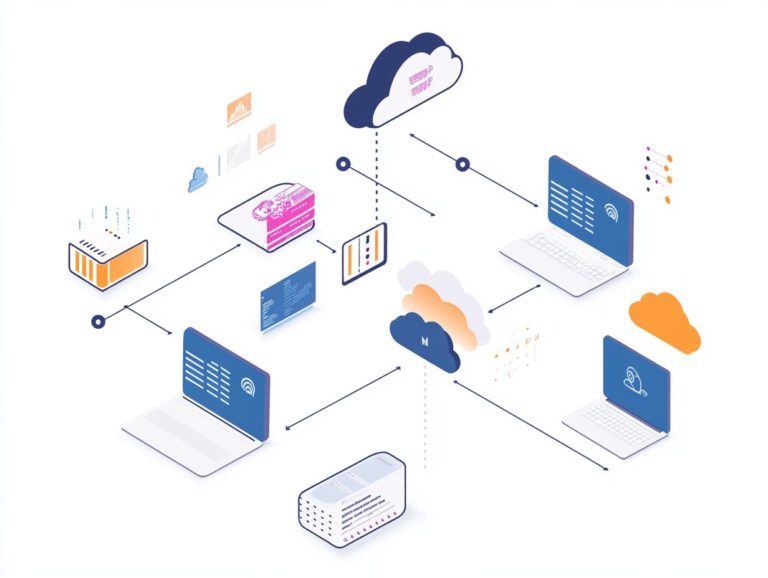The Role of Automation in Cloud Migration
In today s fast-paced digital landscape, cloud migration stands as a pivotal strategy for businesses eager to enhance efficiency and scalability!
This article delves into the essentials of cloud migration, unpacking its definition, benefits, and the challenges you may encounter during the transition. It emphasizes the transformative power of automation and showcases its advantages along with the tools at your disposal.
You ll discover best practices for automating the migration process, complemented by real-world case studies highlighting successful implementations.
Explore strategies to streamline your cloud migration journey and set your organization on a path to success.
Contents
- Key Takeaways:
- Understanding Cloud Migration
- Challenges of Cloud Migration
- The Role of Automation in Cloud Migration
- Best Practices for Automating Cloud Migration
- Case Studies of Successful Automated Cloud Migrations
- Frequently Asked Questions
- What is the role of automation in cloud migration?
- How does automation help in cloud migration?
- What are the benefits of using automation in cloud migration?
- What types of tasks can be automated in the cloud migration process?
- What are some popular automation tools used in cloud migration?
- Is automation necessary for successful cloud migration?
Key Takeaways:

Automation is essential for successful cloud migration! It reduces manual efforts, speeds up the process, and minimizes human errors. For more insights on this topic, check out understanding cloud data migration. Various types of automation tools are available for cloud migration, such as cloud management platforms, configuration management tools, and DevOps tools.
To effectively automate cloud migration, it’s crucial to understand the migration process and develop a well-defined strategy that addresses potential challenges and incorporates best practices, including understanding the role of automated security in cloud.
Understanding Cloud Migration
Cloud migration involves transferring data, applications, and various business components from on-premises servers or legacy systems to cloud-based systems, including public, private, or hybrid clouds.
This transition is vital for IT modernization and digital transformation! It allows businesses to harness cloud-native solutions that significantly enhance agility, efficiency, and scalability.
Ultimately, this shift optimizes performance and helps reduce overall costs, positioning your organization for greater success in a competitive landscape.
Definition and Benefits
Cloud migration entails the seamless transfer of your digital assets to cloud services. This process offers substantial cost reductions and improved scalability while ensuring strict adherence to security compliance standards.
It also facilitates a smoother transition of resources and enhances operational efficiency by consolidating infrastructure management.
Organizations that undertake cloud migration often find that it minimizes business disruptions. The flexibility of cloud solutions makes updates and maintenance a breeze!
One standout benefit is elevated security compliance. Cloud providers typically deliver robust security measures, such as encryption and regular audits, to safeguard your data.
Automation features in cloud platforms streamline many tasks, allowing your teams to dedicate valuable time to strategic initiatives, ultimately fostering innovation and growth.
Challenges of Cloud Migration
Despite the many benefits, you will encounter several challenges during cloud migration, especially when managing legacy systems.
Establishing a robust migration strategy is crucial! It must minimize business disruption while ensuring compliance with security controls and standards.
Identifying and Overcoming Challenges

Identifying and overcoming challenges in cloud migration is essential to ensure a seamless data migration process while upholding security compliance and effective workload management.
Begin your journey by conducting a thorough assessment of your current IT infrastructure. Pinpoint any legacy systems that might present compatibility issues. This evaluation includes examining existing hardware, software, and network capabilities, while also establishing the necessary security compliance requirements.
By understanding these parameters, you empower yourself to make informed adjustments. Application refactoring techniques can help modify existing applications, optimizing their performance for the cloud environment.
Leveraging automation tools can significantly streamline your migration process, reducing potential downtime and minimizing human error, ultimately enhancing your operational efficiency.
Ready to start your cloud migration journey? Let s explore the best solutions for your business!
The Role of Automation in Cloud Migration
Automation serves as a critical factor in cloud migration. It harnesses sophisticated tools and technologies, including the role of DevOps in cloud migration, to streamline your migration process.
This approach optimizes workloads. It also enhances cloud management across the DevSecOps lifecycle, ensuring that your operations remain efficient and compliant.
Benefits of Automation
The benefits of automation in cloud migration go far beyond just boosting efficiency. It significantly enhances your agility and cuts costs while minimizing disruptions to your business during the transition. Understanding the role of project management in cloud migration can further streamline this process.
By utilizing automated tools and processes, you can effortlessly manage workload transfers. This allows for a quicker response to market demands. This approach leads to considerable cost savings by reducing the need for extensive manual oversight and limiting the risk of human error.
Automation is essential for effective risk management. It proactively addresses potential disruptions, enabling your business to maintain continuity while shifting to the cloud.
Ultimately, leveraging automation gives you the power to scale efficiently, innovate at a rapid pace, and adapt dynamically to ever-changing business landscapes.
Types of Automation Tools
You ll find a range of automation tools available for cloud migration, such as Red Hat Ansible and DuploCloud. These tools are designed to facilitate infrastructure provisioning and streamline the entire migration process.
These tools optimize deployment and significantly reduce the risk of human error. This ensures a smoother transition for your organization. For example, Red Hat Ansible utilizes playbooks to automate repetitive tasks, making it simpler for your teams to manage cloud environments effectively.
On the other hand, DuploCloud boasts a user-friendly interface that demystifies complex configurations. This allows you to concentrate on strategic objectives instead of getting bogged down by technical challenges.
Tools like Terraform incorporate infrastructure as code principles. This enables you to maintain consistent environments throughout different stages of development.
Collectively, these automation solutions enhance your efficiency, cut costs, and boost reliability during your migration journey.
Best Practices for Automating Cloud Migration

Implementing best practices for automating cloud migration is crucial for maximizing the benefits of automation. This approach ensures a successful migration strategy and facilitates effective deployment strategies that align seamlessly with your organizational goals.
Key Considerations and Strategies
Key considerations for a successful cloud migration revolve around establishing a clear strategy that emphasizes the benefits of automation, scalability, and security compliance throughout the transition.
You must assess your existing infrastructure to ensure a smooth migration. Pinpoint any potential bottlenecks that could disrupt the process. Adopting a phased approach can help mitigate risks related to data loss or downtime while ensuring adherence to regulatory standards.
Thorough testing is vital to validate performance metrics after the migration. By leveraging tools that enhance visibility into your cloud environment, you can effectively manage resources and optimize your cloud architecture for future growth.
This will create an agile framework that readily adapts to your evolving business needs.
Case Studies of Successful Automated Cloud Migrations
Examining case studies of successful automated cloud migrations provides you with invaluable insights and practical lessons. These can significantly enhance your organization s cloud migration journey, especially when it comes to optimizing enterprise applications.
Real-World Examples and Lessons Learned
Cloud migration examples provide valuable insights. They reveal challenges and success metrics linked to using automation tools.
For instance, a famous retail giant moved its inventory management system to the cloud. This migration uncovered risks like data loss and potential downtime.
The company used tools like Terraform and CloudFormation. This improved deployment processes and reduced human error.
A few months later, the success metrics showed an uptime of over 99.5%! Data retrieval times accelerated by 30%. This evidence proves that automation is key to successful cloud migration.
Frequently Asked Questions

What is the role of automation in cloud migration?
Automation streamlines the process of moving data and applications to the cloud. It uses tools to make tasks quicker and reduce manual effort.
How does automation help in cloud migration?
Automation eliminates manual tasks and reduces errors. It speeds up the migration process and ensures a smooth transition.
What are the benefits of using automation in cloud migration?
Benefits include cost savings and improved efficiency. Automation leads to a faster migration and better resource management.
What types of tasks can be automated in the cloud migration process?
You can automate tasks like data transfer and application deployment. This ensures everything works well in the cloud.
What are some popular automation tools used in cloud migration?
Popular tools include AWS CloudFormation and Terraform. These tools help automate migration tasks like infrastructure setup.
Is automation necessary for successful cloud migration?
While not mandatory, automation greatly improves migration outcomes. It reduces errors and leads to better resource management.






